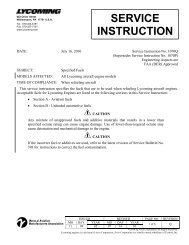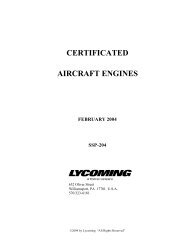Create successful ePaper yourself
Turn your PDF publications into a flip-book with our unique Google optimized e-Paper software.
elatively simple. There are no diaphragm or springs — in general,<br />
very few moving parts. Installation on the engine is simple.<br />
All of this adds up to the significant advantage of being the least<br />
costly method of fuel metering. One additional item should also<br />
be considered. The fuel lines to a carburetor are large enough that<br />
there is little chance of them becoming clogged by the very tiny<br />
particles of foreign matter that may be found in the fuel.<br />
Along with these advantages, the disadvantage frequently<br />
attributed to the carburetor is its inherent capability for<br />
developing ice in the vicinity of the throttle plate. For the pilot<br />
who understands and recognizes carburetor icing, this disadvantage<br />
is easily managed since all certified aircraft are required<br />
to have a carburetor air-heating system which will prevent or<br />
eliminate icing.<br />
Since the fuel injector is more complex and expensive than<br />
a carburetor, why should it be considered? Because the fuel<br />
injector has its own set of advantages which in some cases are<br />
worth the additional cost.<br />
First, the fuel injector causes air and fuel to be mixed at the<br />
cylinder intake port. Therefore, the refrigeration-type icing that<br />
occurs in a carburetor venturi when fuel vaporizes in moist air<br />
cannot happen when a fuel injector is used for fuel metering.<br />
Many pilots consider this to be a significant advantage.<br />
The primary characteristic of the fuel injector is improved fuel<br />
distribution to each cylinder. This feature reduces the possibility<br />
of one cylinder operating at a very lean air/fuel mixture while<br />
another may be operating near the rich end of the mixture scale.<br />
The improved distribution allows leaning that results in slightly<br />
lower overall fuel consumption. This is of particular value in the<br />
higher horsepower engines where saving a small percentage of the<br />
fuel being burned may result in a significant dollar savings.<br />
Finally, the fuel injector will meter fuel regardless of aircraft<br />
attitude while a float-type carburetor can only operate in an<br />
upright position. This advantage, of operating in any attitude,<br />
makes the fuel injector an ideal fuel-metering device for the<br />
engine that is designed for aerobatics.<br />
Questions that frequently are asked of <strong>Lycoming</strong> sales personnel,<br />
engineers and technical representatives indicate that<br />
among aircraft owners and aviation writers there is a myth<br />
regarding <strong>Lycoming</strong> piston engines. Many of these individuals<br />
assume each <strong>Lycoming</strong> engine in a series to be essentially<br />
the same. For example, some believe that all 360-cubic inch<br />
displacement engines are inherently the same except for differences<br />
in fuel metering or turbocharging. The idea that these<br />
engines are the same is false. A few specific examples may help<br />
to put this myth to rest.<br />
<strong>Lycoming</strong> builds O-320 engines that produce 150 HP or 160 HP.<br />
The 150 HP O-320-E series engines operate at a compression ratio<br />
of 7.0:1. The O-320-D series has high-compression pistons which<br />
8 L y c o m i n g F l y e r<br />
raise the compression ratio to 8.5:1, and increase rated output to<br />
160 HP. Those who believe that the pistons are the only difference<br />
in these engines will be disappointed if they plan to upgrade their<br />
O-320-E to the higher horsepower by simply changing pistons.<br />
Many models in the O-320-E series were designed for economy.<br />
Thousands of these low-compression engines were built with plain<br />
steel cylinder barrels instead of the nitrided barrels used in the<br />
O-320-D series engines. They also had two narrow bearings<br />
instead of one long front main bearing. The engines were certified<br />
at 150 HP and were not intended to withstand the additional<br />
stress of higher horsepower.<br />
Because of the similarity in designation, it would be easy to<br />
believe that the O-360-AlA and the IO-360-A1A are the same<br />
engine except that the first engine has a carburetor and the<br />
second a fuel injection system. Here are some features of each<br />
engine for comparison. The O-360-AlA has a bottom-mounted<br />
updraft carburetor, parallel valves, 8.5:1 compression ratio<br />
and produces 180 HP. The IO-360-AlA features a horizontal<br />
front-mounted fuel injector, angle valves, 8.7:1 compression<br />
ratio, and is rated at 200 HP. The IO-360-A1A incorporates<br />
additional design items which are not included in the<br />
O-360: piston cooling nozzles, stronger crankshaft, tongue and<br />
groove connecting rods with stretch bolts, tuned intake system<br />
and rotator type intake valves. There are actually few similarities<br />
except for the 360-cubic inch displacement.<br />
There have been suggestions that by putting 10:1 compression<br />
ratio pistons in an IO-360 engine, it could be the same<br />
as the HIO-360-D1A. These are some characteristics of the<br />
HIO-360-D1A helicopter engine that can be compared with<br />
the data on the IO-360 listed in the previous paragraph. To<br />
start, the HIO has conical rather than dynafocal mounts. The<br />
main bearing is a thick-wall bearing instead of the thin-wall,<br />
high-crush bearing used in the IO-360. Other differences include:<br />
crankshaft designed for small crankpins, high-speed camshaft,<br />
rear-mounted RSA7AA1 fuel injector, large intake valves and<br />
torsional vibration damper magneto drives.<br />
Finally, both the Navajo engines and the turbocharged<br />
<strong>Lycoming</strong> used in the Mooney TLS are equipped with differential<br />
and density controllers that automatically set the<br />
maximum allowable horsepower when the throttle is advanced<br />
fully for takeoff. Some believe that the TIO-540-AF1A<br />
which powers the Mooney TLS is simply a derated Navajo<br />
engine. This conclusion could hardly be more inaccurate. The<br />
most obvious difference, even to the complete novice can be seen<br />
by looking at the rocker box covers. The TIO-540-AF1A is rated<br />
at 270 HP and has parallel valve-down exhaust cylinders. The<br />
Navajo series has three engines at 310 HP, 325 HP and 350 HP.<br />
All have cylinders designed with up exhaust and angle valves.<br />
Other differences respectively in the 270 HP AF1A and the<br />
Navajo series engines are: small main bearing instead of large<br />
main bearing, 8.0:1 compression ratio rather than 7.3:1, intercooled<br />
and non-intercooled, pressurized Slick magnetos versus<br />
Bendix/TCM magnetos and an RSA5AD1 fuel injector in place<br />
of the RSA10AD1 injector. There are some other differences, but<br />
those comparisons listed should convince even the most skeptical<br />
that these engines are vastly different.







